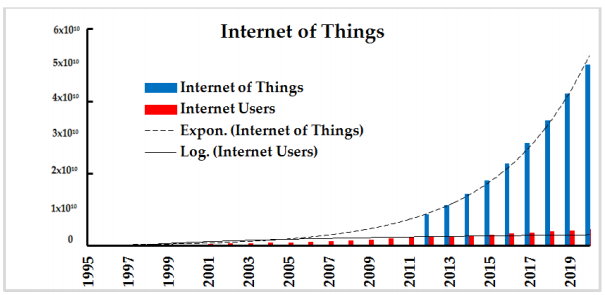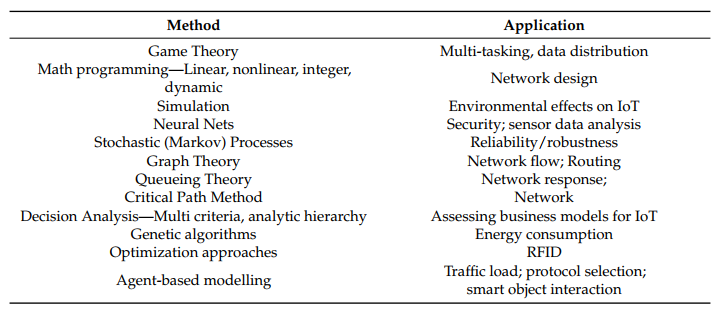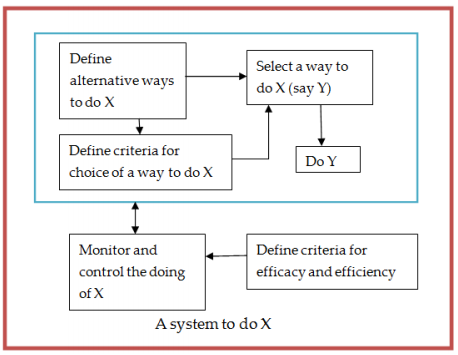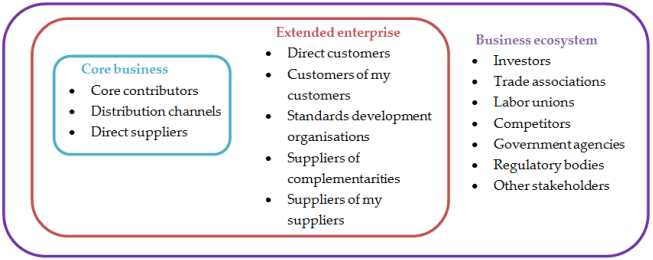ABSTRACT
The Internet of Things (IoT) is an extension of the Internet in which large numbers of “things”, including sensors, actuators and processors, in addition to human users, are networked and able to provide high resolution data on their environment and exercise a degree of control over it. It is still at an early stage of development, and many problems/research challenges must be solved before it is widely adopted. Many of these are technical, including interoperability and scalability, as billions of heterogeneous devices will be connected, but deciding on how to invest in the IoT is a challenge for business, and there are also major social, legal and ethical challenges, including security and privacy of data collection, which must be resolved.
As the future IoT will be a multi-national, multi-industry, multi-technology infrastructure, the paper reviews the global standardization efforts that are underway to facilitate its worldwide creation and adoption. The main purpose of the paper is to give a broad survey, based on published literature, of the methods of Operations Research (OR), both the mathematical tools and techniques of “hard” OR, and the various approaches of Systems Thinking, including “soft” OR, which may assist in dealing with these problems. A subset of these is described in greater depth to better convey what might be involved in applying OR and Systems Thinking to the IoT. It is suggested that OR has a role to play in balancing the technical and non-technical research challenges which confront the IoT.
THE INTERNET OF THINGS

Figure 1. Internet of Things growth
The IoT is regarded as the next phase in the evolution of the internet. It will enable commonplace devices to be connected to the internet to achieve many disparate goals. With potentially billions of devices to be connected, it is clear that standardization will be required in order to avoid chaos.
One estimate is that only 0.6% of objects that could be part of the IoT are currently connected. By 2020, there could be up to 50 billion devices connected to the internet, far greater than the number of human users as shown in Figure 1 below. The growth in the IoT follows an exponential curve while the growth in the number of human users follows a logarithmic curve.
HOW CAN OR SUPPORT THE FUTURE IOT?

Table 3. Mathematical OR techniques applied to IoT
Table 3 contains a non-exhaustive list of mathematical OR techniques that have been applied to understand and develop the IoT.
DETAILED DISCUSSION OF SOME IOT RESEARCH CHALLENGES WHICH OR AND SYSTEMS THINKING MAY HELP ADDRESS

Figure 2. Scaling in IoT networks with: (a) 4 nodes; (b) 16 nodes; and (c) 64 nodes (red circles represents sensors; black circles actuators)
A simple visualization can show how IoT networks can rapidly become extremely complex. Figure 2 shows three IoT networks composed of equal numbers of sensors and actuators where all nodes are connected to each other. The number of connections grows rapidly from only 6 for a 4-node network, 120 for a 16-node network to 2016 for a 64-node network, since the number of connections for such an N-node network is trivially N × (N − 1)/2.

Figure 3. A Soft Systems Methodology (SSM) abstract conceptual model
To introduce the idea, Figure 3 is a type of abstract conceptual model, which is a set of very general activities which could be tailored to any root definition. In a context-aware system, a service can be provided in different ways, depending on the context. Context modelling defines the alternative ways, and the criteria for selecting which one or more ways will be acted on. As in all correctly constructed SSM conceptual models, activities are needed to monitor the doing and taking control action to try to ensure the meeting of criteria of efficacy (is the system doing what it is supposed to?) and efficiency (is it being done with a minimum use of resources?).

Figure 8. Generic actors in a business ecosystem (redrawn from Mazhelis et al.)
Business investment in the IoT is going to be much more complex than investments in the products and services of an individual firm, and even more complex than currently existing investments in e-commerce over the Internet. New business models for the IoT which view it as a “business ecosystem” will need to be developed. This is “a complex adaptive system (whose) population develops through co-evolution with the greater environment, self-organization and emergence (i.e., the ability and process to create new order), and adaptation to the environment” (Peltoniemi quoted in Westerlund et al.). This is shown in Figure 8.
CONCLUSIONS
This paper gives a brief overview of the Internet of Things (IoT), research challenges to its design, use and widespread adoption, and the important contemporary worldwide efforts to develop interoperability standards. The aim of the paper is to survey the application of Operations Research (OR) methods, including the OR sub-discipline of Systems Thinking, to the IoT. The methods were subdivided into “hard” OR tools and techniques, which mainly address the technical and business challenges of the IoT, and Systems Thinking approaches, which can address both technical, business and non-technical challenges, including social, legal and ethical challenges.
The research for the paper included review of a very large number of journal articles, conference papers and industry reports on the IoT, the numbers of which are rapidly increasing as the IoT has become a popular area for academic research and business investment. Most of this work is theoretical and few case studies have been reported. Reports on the application of OR and Systems Thinking to the IoT have so far been relatively scarce, although their numbers can be expected to increase in future years. Nevertheless, we were surprised at the amount of work on OR applied to the IoT that is out there, so far mainly in conference papers. The OR journals have been slower to report this application area, although many papers on the adoption of new technology in general have appeared in recent years.
Our review has shown that OR techniques are starting to be applied to some of the major research challenges of the IoT, particularly that of Data Management, where the OR sub-discipline of Data Analytics is developing new approaches to the analysis of “big data” and has become a field whose skills are much in demand by business. The challenge of developing business models for investing in the IoT is also seeing a significant amount of work done by OR practitioners in the field of Decision Analysis, including Game Theory, Analytical Hierarchy Process (AHP) and Data Envelopment Analysis (DEA).
The more Information and Communications Technology (ICT)-oriented challenges of the IoT such as network architecture have not attracted as much OR attention as yet, although the OR techniques of Routing and Graph Theory have much potential for contributing to the solution of such problems. Few case studies which attempt to evaluate the efficiency and effectiveness of the IoT have been reported, partly due to its complexity and partly due to the lack of real-world data with which to evaluate such performance measures as return-on-investment (Houston et al.).
Source: DSTG
Authors: Peter J.Ryan | Richard B.Watson
>> Latest 50+ IoT based Security Projects for Engineering Students
>> IoT based Big Data and Cloud Computing Projects for B.E/B.Tech Students
>> 200+ IoT Led Projects for Engineering Students